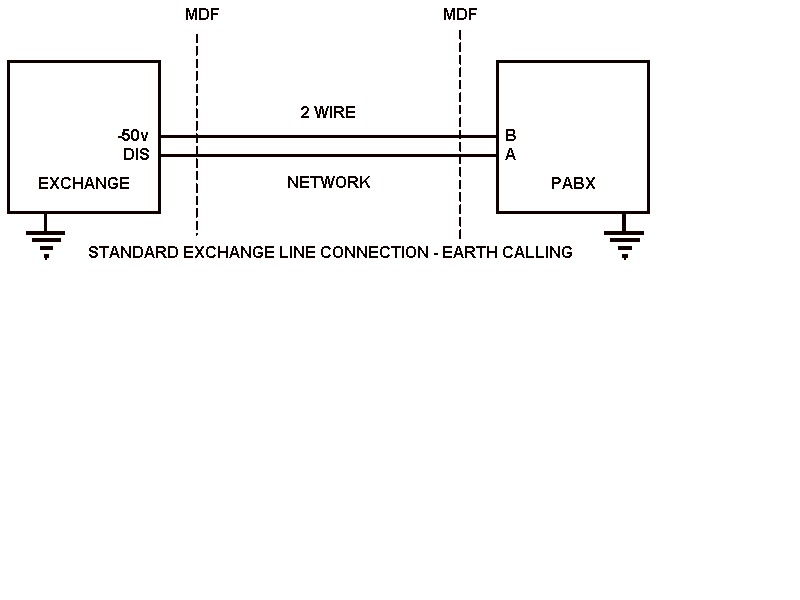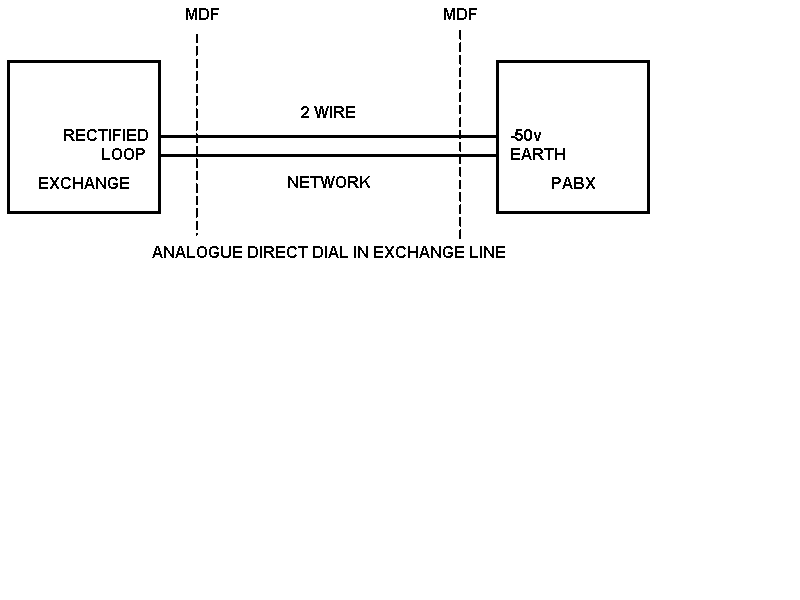| In the UK we call lines that connect to the network provider exchange lines. In the US
and elsewhere in the world they are know as trunks or CO lines (central office).
Other PTO's use exchange lines with different operating conditions and these can
be country dependant.
The exchange line types on Automatic exchanges in general use are listed below.
Loop Calling
The line is seized by a loop condition, put on at the customer end. This is
normally used on residential and small key systems, you pick up the phone and the line is seized.
Testing
A 50v dc condition will be found across the A and B wires. A reversal should not
generally matter,
but the -50v theoretically should be on the B wire and an earth (ground) on the A wire.

Earth Calling
Used on medium to large customer telephone systems (PABX's). This type of line is supposed to stop call collision,
which can be described as an incoming call which is answered by an outgoing call (both o/g
and i/c seized the line at the same time). Earth calling lines where designed to guard
against this. The customer telephone system puts an earth on the B leg when making
o/g calls and this causes the exchange to seize. The exchange then looks for a loop which
the telephone system extends once the earth condition has been taken off. The
customer system must be connected to a good earth.
Testing
There will only be a -50v present on one wire and this must be on the B wire. -50v on the
A wire is known as a line reversal and will not work! Check for -50v on the B wire
at the telephone system port with a meter connected to a good earth.
The A leg has no line condition.

DDI
This type of line is used for direct dialling in (DDI). The exchange dials into the
customers telephone system using loop dialling and the customer system then routes these
digits to a predefined destination, usually an extension number. The network provider
supplies the incoming number range and normally only the last two or three
digits of the
customers telephone number are sent. DDI lines are controlled by the customer telephone
system and have no facility for outgoing calls. The telephone system extends a 50v
condition to line. These operate in the same manner as loop calling lines but are polarity
conscious.
Reversals can only be identified at the network exchange end.
Testing
Disconnect the incoming wiring and connect a telephone to the port and dial (loop dial) the expected digits into the customer
system. The extension should ring and should be able to speak when answered.
Disconnecting the 50v at the customer end busies out the line and is a good tool to use
whilst testing.

DASS2
Whilst not analogue it is worth mentioning it here. This type of line is totally digital.
DASS2 is a UK protocol that is now being superseded by the European
specification ISDN 30. The line is a 32 channel PCM link with 30 of the channels
used for speech and two used for signalling, messaging and timing.
Testing
A specialist tester must be used or co-operation with the network provider. A loop back
lead is advisable for any person attempting to test these circuits.
DISA
An earth or loop calling line that is programmed at the customers end allows incoming dialling. Normally the line is
tripped by the telephone system and dial tone returned to the incoming caller. The caller then dials directly into the
telephone system or has to put in a password. Good practice calls for the provision of a password to prevent illegal calls
being made.
Line Signalling Systems
Book
|


